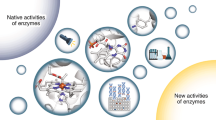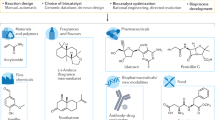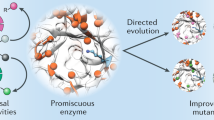Abstract
While the use of enzymes as biocatalysts to assist in the industrial manufacture of fine chemicals and pharmaceuticals has enormous potential, application is frequently limited by evolution-led catalyst traits. The advent of designer biocatalysts, produced by informed selection and mutation through recombinant DNA technology, enables production of process-compatible enzymes. However, to fully realize the potential of designer enzymes in industrial applications, it will be necessary to tailor catalyst properties so that they are optimal not only for a given reaction but also in the context of the industrial process in which the enzyme is applied.
This is a preview of subscription content, access via your institution
Access options
Subscribe to this journal
Receive 12 print issues and online access
$209.00 per year
only $17.42 per issue
Buy this article
- Purchase on Springer Link
- Instant access to full article PDF
Prices may be subject to local taxes which are calculated during checkout

© Bob Crimi

© Bob Crimi


© Bob Crimi
Similar content being viewed by others
References
Halling, P.J. Biocatalysis in low-water media: understanding effects of reaction conditions. Curr. Opin. Chem. Biol. 4, 74–80 (2000).
Wangikar, P.P, Michels, Clark, D.S. & Dordick, J.S. Structure and function of subtilisin BPN solubilized in organic solvents. J. Am. Chem. Soc. 119, 70–76 (1997).
Kazlauskas, R.J. Molecular modelling and biocatalysis: explanations, predictions, limitations and opportunities. Curr. Opin. Chem. Biol. 4, 81–88 (2000).
Selleck, G.A. & Chaudhuri, J. B. Biocatalysis in organic media using enzymes from extremophiles. Enzyme Microb. Technol. 25, 471–482 (1999).
Schmitke, J.L., Stern, L.J. & Klibanov, A.M. The crystal structure of subtilisin Carlsberg in anhydrous dioxane and its comparison with those in water and acetonitrile. Proc. Natl. Acad. Sci. USA 94, 4250–4255 (1997).
Aguilar, C.F. et al. Crystal structure of the β-galactosidase from the hyperthermophilic archaeon Sulfolobus solfaricus: resilience as a key factor in thermostability. J. Mol. Biol. 271, 789–802 (1997).
Villeret, V. et al. The crystal structure of Pyrococcus furiosus ornithine carbamoyltransferase reveals a key role for oligomerisation in enzyme stability at extremely high temperatures. Proc. Natl. Acad. Sci. USA 95, 2801–2806 (1998).
Martin A.B. & Schulze, P.G. Opportunities at the interface of chemistry and biology. Trends Biochem. Sci.. 24, M24–M28 (1999).
Arnold, F.H. & Volkov, A.A. Directed evolution of biocatalysts. Curr. Opin. Chem. Biol. 3, 54–59 (1999).
Arnold, F.H. Design by directed evolution. Acc. Chem Res. 31, 125–131 (1998).
Affholter, J. & Arnold, F.H. Engineering a revolution. ChemTech. 26, 34–39 (1999).
Tapolczay, D.J., Kobylecki, R.J., Payne, L.J. & Hall, B. Extracting order from chaos. Chem. Ind. 19, 772–775 (1998).
Woodley, J.M. & Lilly, M.D. Process engineering of two-liquid phase biocatalysis. Prog. Biotechnol. 8, 147–154 (1992).
Wandrey, C., Liese, A. & Kihumbu, D. Industrial biocatalysis: past, present and future. Org. Process Res. Dev. 4, 286–290 (2000).
Flitsch, S.L., Aitken, S.J., Cho, C.S.Y., Grogan, G. & Staines, A. Biohydroxylation reactions catalysed by enzymes and whole-cell systems. Bioorg. Chem. 27, 81–90 (1999).
Sette, L., Lanzarini, G. & Pifferi, P.G. Whole cell biocataysis for an oil desulphurization process. Fuel Process. Technol. 52, 145–153 (1997).
Woodley, J.M. & Lilly, M.D. Biotransformation reactor selection and operation. In Applied biocatalysis. (eds Cabral, J.M.S., Best, D., Boross L. & Tramper J.) 371–393 (Harwood Academic, London; 1994).
Chauhan, R.P. & Woodley, J.M. Increasing the productivity of bioconversion processes. ChemTech 27, 26–30 (1997)
Shanklin, J. Exploring the possibilities presented by protein engineering. Curr. Opin. Plant Biol. 3, 243–248 (2000)
Tischer, W. & Kasche, V. Immobilised enzymes: crystals or carriers? Trends Biotechnol. 17, 326–335 (1999).
Adlercreutz, P. On the importance of the support material for enzymatic synthesis in organic media—support effects at controlled water activity. Eur. J. Biochem. 199, 609–614 (1991).
Kim, J. & Dordick, J.S. Unusual salt and solvent tolerance of a protease from an extreme halophile. Biotechnol. Bioeng. 55, 471–479 (1997).
Toba, S. & Mez, K.M. The concept of solvent compatibility and its impact on protein stability and activity enhancement in non-aqueous solvents. J. Am. Chem. Soc. 119, 9939–9948 (1997).
Jaeger, K.-E. & Reetz, M.T. Directed evolution of enantioselective enzymes for organic chemistry. Curr. Opin. Chem. Biol. 4, 68–73 (2000).
Altamirano, M.M., Blackburn, J.M., Aguayo, C. & Fersht, AR. Directed evolution of a new catalytic activity using alpha/beta barrel scaffold. Nature 403, 617–622 (2000).
May, O., Nguyen, P.T., & Arnold, F.H. Inverting enantioselectivity and increasing total activity of a key enzyme in a multi-enzyme synthesis creates a viable process for production of l-methionine. Nat. Biotechnol. 18, 317–320 (2000).
Kumamaru, T., Suenaga, H., Watanabe, T. & Furukawa, K. Enhanced degradation of polychlorinated biphenyls by directed evolution of biphenyl dioxygenase. Nat. Biotechnol. 16, 663–666 (1998).
Hough, D. & Danson, M.J. Extremozymes. Curr. Opin. Chem. Biol. 3, 39–36 (1999).
Daniel, R.M. & Cowan, D.A. Biomolecular stability and life at high temperatures. Cell. Mol. Life Sci. 57, 250–264 (2000)
Jaenicke, R. & Bohm, G. The stability of proteins in extreme environments. Curr. Opin. Struct. Biol. 8, 738–748 (1998).
Lee, B. & Vasmatzis, G. Stabilization of protein structures. Curr. Opin. Biotechnol.. 8, 423–428 (1999).
Kuchner, O. & Arnold, F.H. Directed evolution of enzyme catalysts. Trends Biotechnol. 15, 523–530 (1997).
Giver, L., Gershenson, A, Freskard, P.O. & Arnold, F.H. Directed evolution of a thermostable esterase. Proc. Natl. Acad. Sci. USA 95, 12809–12813 (1998).
Van den Burg, B., Vriend, G., Venema, O.R. & Eijsink, V.G. Engineering an enzyme to resist boiling. Proc. Natl. Acad. Sci. USA 95, 2056–2060 (1998).
Daniel, R.M., Cowan, D.A., Curran, M. & Morgan, H.W. A correlation between protein thermostability and susceptibility to proteolysis. Biochem. J. 207, 641–644 (1982).
Owusu, R.K. & Cowan, D.A. A correlation between microbial protein thermostability and resistance to denaturation in aqueous–organic solvent two-phase systems. Enz. Microb. Technol. 11, 568–574 (1989).
Richins, R.D., Kaneva, I., Mulchandari, A., & Chen, W. Biodegradation of organophosphorus pesticides by surface-expressed organophosphorus hydrolase. Nat. Biotechnol. 15, 984–987 (1997).
Jung, H.C., Lebeault, J.M. & Pan, J.G. Surface display of Zymomonas mobilis levansucrase by using ice-nucleation protein of Pseudomonas syringae. Nat. Biotechnol. 16, 576–580 (1998).
Blanco, R.M. &, Guisan, J.M. Stabilization of enzymes by multipoint covalent attachment to agarose aldehyde gels—borohydride reduction of trypsin agarose derivatives. Enz. Microb. Technol. 11, 360–366 (1989).
Häring, D. & Schreier, P. Cross-linked enzyme crystals. Curr. Opin. Chem. Biol. 3, 35–38 (1999).
Stemmer, W.P.C. Searching sequence space—using recombination to search more efficiently and thoroughly instead of making bigger combinatorial libraries. Bio/Technol. 13, 549–553 (1995).
Amann, R.I., Ludwig, W. & Schleiffer K.H. Phylogenetic identification and in-situ detection of individual microbial cells without cultivation. Microbiol. Rev. 59, 143–169 (1995).
Cottrell, M.T., Moore, J.A. & Kirchman, D.L. Chitinases from uncultured marine microorganisms. Appl. Environ. Microbiol. 65, 2553–2557 (1999).
Cowan, D.A. Microbial genomes-the untapped resource. Trends Biotechnol. 18, 14–16 (2000).
Henne, A., Schmitz, R.A., Bömeke, M., Gottschalk, G. & Daniel, R. Screening of environmental DNA libraries for the presence of genes conferring lipolytic activity on Escherichia coli. Appl. Environ. Microbiol. 66, 3113–3116 (2000).
Rondon, M.R. et al. Cloning the soil metagenome: a strategy for accessing the genetic and functional diversity of uncultured microorganisms. Appl. Environ. Microbiol. 66, 2541–2547 (2000).
Petrounia, I.P. & Arnold, F.H. Designed evolution of enzymatic properties. Curr. Opin. Biotechnol. 11, 325–330 (2000).
Jaenicke, R. & Bohm, G. The stability of proteins in extreme environments. Curr. Opin. Struct. Biol. 8, 738–748 (1998).
Malakauskas, S.M. & Mayo, S.L. Design, structure and stability of a hyperthermophilic protein variant. Nat. Struct. Biol. 5, 470–475 (1998).
Chen K. & Arnold, F. Tuning the activity of an enzyme for unusual environments: sequential random mutagenesis of subtilisin E for catalysis in dimethylformamide. Proc. Natl. Acad. Sci. USA 90, 5618–5622 (1993).
Wehtje, E. & Adlercreutz, P. Water activity and substrate concentration effects on lipase activity. Biotechnol. Bioeng. 55, 798–806 (1997).
Burton, S.G., Duncan, J.R., Kaye P.T. & Rose P.D. Activity of mushroom polyphenol oxidase in organic medium. Biotechnol. Bioeng. 42, 938–946 (1994).
Reimann, A., Robb, D.A. & Halling, P.J. Solvation of CBZ–amino acid nitrophenyl esters in organic media and the kinetics of their transesterification by subtilisin. Biotechnol. Bioeng. 43, 1081–1086 (1994).
Khemelnitsky, Y.L., Welch, S.H., Clark, D.S & Dordick, D.S. Salts dramatically enhance activity of enzymes suspended in organic solvents. J. Am. Chem. Soc. 116, 2647–2648 (1994).
Ru, M.T., Dordick, J.S., Reimer, J.A. & Clark, D.S. Optimising the salt-induced activation of enzymes in organic solvents: effects of lyophilisation time and water content. Biotechnol. Bioeng. 63, 233–241 (1999).
Schmid, A., Dordick, J.S., Haven, B., Wubbolts, M. & Witholt, B. Industrial biocatalysis today and tomorrow. Nature 409, 258–268 (2001).
Liese, A., Seelbach, K. & Wandrey, C. Industrial biotransformations. (Wiley-VCH, Weinheim, Germany; 2000).
Wang, P., Sergeeva, M.V., Lim, L. & Dordick J.S. Biocatalyst plastics as active and stable materials for biotransformations. Nat. Biotechnol. 15, 789–793 (1997).
Partridge, J., Halling, P.J. & Moore, B.D. Practical route to high activity enzyme preparations for synthesis in organic media. Chem. Commun. 7, 841–842 (1998).
Rich, J.O. & Dordick, J.S. Controlling subtilisin activity and selectivity in organic media by imprinting with nucleophilic substrates. J. Am. Chem. Soc. 119, 3245–3252 (1997).
Slade C.J. & Vulfson, E.N. Induction of catalytic activity in proteins by lyophilization in the presence of a transition state analogue. Biotechnol. Bioeng. 57, 211–215 (1998).
Reetz, M.T., Zonta, A., Schimossek, K., Liebeton, K. & Jaeger, K.-E. Creation of enantioselective biocatalysts for organic chemistry by in vitro evolution. Angew. Chem., Int. Edn. Engl. 36, 2830–2833 (1997).
Bornscheuer, U.T, Altenbuchner, J. & Meyer, H.H. Directed evolution of an esterase for the stereoselective resolution of a key intermediate in synthesis of epithilones. Biotechnol. Bioeng. 58, 554–559 (1998).
Sutherland, J.D. Evolutionary optimization of enzymes. Curr. Opin. Chem. Biol. 4, 263–269 (2000).
Broun, P., Shanklin, J., Whittle, E. & Somerville, C. Catalytic plasticity of fatty acid modification enzymes underlying chemical diversity of plant lipids. Science 282, 1315–1317 (1998).
Zhang, J.H., Dawes, G., & Stemmer, W.P. Directed evolution of a fucosidase from a galactosidase by DNS shuffling and screening. Proc. Natl. Acad. Sci. USA 94, 4504–4509 (1997).
Zhao, H. & Arnold, F. Directed evolution converts subtilisin E into a functional equivalent of thermitase. Protein Eng. 12, 47–52 (1999).
Fernandez-Lafuente, R., Cowan, D.A. & Wood, A.N.P. Hyperstabilisation of a thermophilic esterase by multipoint covalent attachment. Enz. Microb. Technol. 17, 366–372 (1995).
Kazan, D., Ertan, H. & Eraslan, A. Stabilisation of Escherichia coli penicillin G acylase against thermal inactivation by cross-linking with dextran dialdehyde polymers. Appl. Microbiol. Biotechnol. 48, 191–197 (1997).
Häring, D. & Schreier, P. Novel biocatalysts by chemical modification of known enzymes: cross-linked microcrystals of the semi-synthetic peroxidase seleno-subtilisin. Agnew. Chem. Int. Edn. Engl. 37, 2471–2473 (1998).
Mori, T. & Okahata, Y. A variety of lipid-coated glycoside hydrolases as effective glycosyl transfer catalysts in homogenous organic solvents. Tetrahedron Lett. 38, 1971–1974 (1997).
Jene, O., Pearson, J.C. & Lowe, C.R. Surfactant modified enzymes: solubility and activity of surfactant-modified catalase in organic solvents. Enz. Microb. Technol. 20, 69–74 (2000).
Moore, J.C. & Arnold, F.H. Directed evolution of a para-nitrobenzyl esterase for aqueous–organic solvents. Nat. Biotechnol. 14, 458–462 (1996).
Bull, A.T., Goodfellow, M. & Slater, J.H. Biodiversity as a source of innovation in biotechnology. Ann. Rev. Microbiol. 46, 219–252 (1992)
Margesin, R. & Schinner, F. Characterization of a metalloprotease from psychrophilic Xanthomonas maltophilia. FEMS Microbiol. Lett. 79, 257–261 (1991).
Giménez, M.I., Studdert, C.A., Sánchez, J.J. & De Castro, R.E. Extracellular protease of Natrialba magadii: purification and biochemical characterisation. Extremophiles 4, 181–188 (2000).
Cowan, D.A. & Daniel, R.M. Purification and some properties of an extracellular protease (Caldolysin) from an extreme thermophile. Biochim. Biophys. Acta. 705, 293–305 (1982).
Cowan, D.A., Smolenski, K.A., Daniel, R.M. & Morgan, H.W. An extremely thermostable extracellular protease from a strain of the archaebacterium Desulfurococcus growing at 88°C. Biochem. J. 247, 121–133 (1987).
Acknowledgements
The authors gratefully acknowledge the financial support for their research from the UK Biotechnology and Biological Sciences Research Council and the South African National Research Foundation.
Author information
Authors and Affiliations
Corresponding author
Rights and permissions
About this article
Cite this article
Burton, S., Cowan, D. & Woodley, J. The search for the ideal biocatalyst. Nat Biotechnol 20, 37–45 (2002). https://doi.org/10.1038/nbt0102-37
Received:
Accepted:
Issue Date:
DOI: https://doi.org/10.1038/nbt0102-37
This article is cited by
-
Synthesizing Chiral Drug Intermediates by Biocatalysis
Applied Biochemistry and Biotechnology (2020)
-
The Intrinsic Enzyme Activities of the Classic Polyoxometalates
Scientific Reports (2019)
-
Target Discovery of Novel α-l-Rhamnosidases from Human Fecal Metagenome and Application for Biotransformation of Natural Flavonoid Glycosides
Applied Biochemistry and Biotechnology (2019)
-
Accelerating the implementation of biocatalysis in industry
Applied Microbiology and Biotechnology (2019)
-
In silico characterization of the global Geobacillus and Parageobacillus secretome
Microbial Cell Factories (2018)



